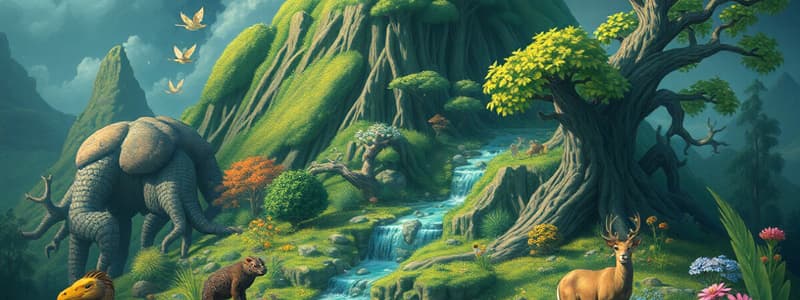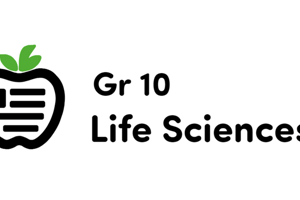Podcast
Questions and Answers
Which of the following best describes the concept of biodiversity?
Which of the following best describes the concept of biodiversity?
- The different types of ecosystems in the world.
- The total number of individual organisms in a particular region.
- The variety of life forms including species, genetic variation, and ecosystems. (correct)
- The study of the distribution of different species.
Which of these is NOT considered a major threat to biodiversity?
Which of these is NOT considered a major threat to biodiversity?
- Climate change.
- Successful conservation efforts. (correct)
- Habitat destruction.
- Invasive species.
An organism's scientific name uses the binomial nomenclature system. What does this system provide?
An organism's scientific name uses the binomial nomenclature system. What does this system provide?
- A way to classify based on general characteristics.
- A method to track genetic mutations.
- A two-part name based on the genus and species. (correct)
- A single common name for all species.
In a cladogram, what do the branching points represent?
In a cladogram, what do the branching points represent?
What is the primary difference between homologous and analogous structures?
What is the primary difference between homologous and analogous structures?
Which of these is the best definition of 'evolution'?
Which of these is the best definition of 'evolution'?
Which of the these mechanisms, is NOT a key mechanism of evolution?
Which of the these mechanisms, is NOT a key mechanism of evolution?
What do viral capsids and bacterial cell walls have in common?
What do viral capsids and bacterial cell walls have in common?
Which process directly results in a reduction of chromosome number?
Which process directly results in a reduction of chromosome number?
What is the relationship between a phenotype and a genotype?
What is the relationship between a phenotype and a genotype?
Which of the following is an example of prezygotic isolation?
Which of the following is an example of prezygotic isolation?
Which of the following best describes allopatric speciation?
Which of the following best describes allopatric speciation?
Where in the body is the control of breathing primarily located?
Where in the body is the control of breathing primarily located?
Which type of blood vessel is responsible for the exchange of gases and nutrients with tissues?
Which type of blood vessel is responsible for the exchange of gases and nutrients with tissues?
What is the primary function of the xylem in plants?
What is the primary function of the xylem in plants?
Which of these options describes the movement of sugars in plants?
Which of these options describes the movement of sugars in plants?
Which of the following is an example of a non-vascular plant?
Which of the following is an example of a non-vascular plant?
In a monohybrid cross, what does the law of segregation describe?
In a monohybrid cross, what does the law of segregation describe?
Flashcards
Biodiversity
Biodiversity
The variety of life forms in a particular place or on Earth, including the diversity of species, genetic variations, and ecosystems.
Natural Selection
Natural Selection
A natural process where organisms with traits better suited to their environment survive and reproduce more successfully.
Evolution
Evolution
The change in the genetic makeup of a population over time. It can be caused by factors like mutations, natural selection, and genetic drift.
Classification
Classification
Signup and view all the flashcards
Binomial Nomenclature
Binomial Nomenclature
Signup and view all the flashcards
Cladogram
Cladogram
Signup and view all the flashcards
Analogous Structures
Analogous Structures
Signup and view all the flashcards
Homologous Structures
Homologous Structures
Signup and view all the flashcards
What are gametes and how are they produced?
What are gametes and how are they produced?
Signup and view all the flashcards
What's the difference between phenotype and genotype?
What's the difference between phenotype and genotype?
Signup and view all the flashcards
What is a Punnett square and how is it used?
What is a Punnett square and how is it used?
Signup and view all the flashcards
How are pedigrees used to study inheritance patterns?
How are pedigrees used to study inheritance patterns?
Signup and view all the flashcards
What are prezygotic and postzygotic isolation?
What are prezygotic and postzygotic isolation?
Signup and view all the flashcards
What are allopatric and sympatric speciation?
What are allopatric and sympatric speciation?
Signup and view all the flashcards
What are the phases of meiosis?
What are the phases of meiosis?
Signup and view all the flashcards
How does mitosis differ from meiosis?
How does mitosis differ from meiosis?
Signup and view all the flashcards
What are the laws of segregation and independent assortment?
What are the laws of segregation and independent assortment?
Signup and view all the flashcards
How do crossing over and independent assortment lead to diverse gametes?
How do crossing over and independent assortment lead to diverse gametes?
Signup and view all the flashcards
Study Notes
Biodiversity
- Biodiversity is the variety of life forms in an ecosystem or on Earth, including the diversity of species, genes, and ecosystems.
- Key threats to biodiversity include habitat loss, pollution, climate change, invasive species, and over-exploitation.
- Organisms are classified into domains (Archaea, Bacteria, Eukarya) and kingdoms (e.g., Plantae, Animalia, Fungi, Protista) based on characteristics like cell structure, genetic makeup, and evolutionary history.
- Classification uses a hierarchical system: Domain, Kingdom, Phylum, Class, Order, Family, Genus, Species.
- Binomial nomenclature uses a two-part Latin name (Genus species) to identify each species.
- Organisms are classified based on physical traits, genetic information, evolutionary history, and reproductive methods; this is important for understanding evolutionary relationships.
- Interactions between organisms, like mutualism, competition, and parasitism, are crucial aspects of biodiversity.
- Cladograms illustrate the evolutionary relationships between organisms, showcasing shared traits and ancestry.
- Knowledge of bacterial and viral structures (like cell walls, flagella, capsids) is essential.
- Biodiversity connects to other units of study, including ecology, evolution, and organism classification.
Evolution
- Evolution is the change in species over time due to genetic variations and natural selection.
- Key mechanisms driving evolution are natural selection, mutations, genetic drift, gene flow, and non-random mating.
- Evolution's real-world impact and effects are illustrated through examples like Darwin's finches or antibiotic resistance.
- Evidence supporting evolution comes from fossils, comparative anatomy (homologous and analogous structures), genetic data, and embryology.
- Analogy is a similarity in function but different evolutionary origins; homology is similarity due to common ancestry.
- Evolution links to concepts in other subjects, such as anatomy, genetics, and biodiversity.
Genetics
- Gametes (sex cells) are haploid (one set of chromosomes), while somatic cells are diploid (two sets).
- Gametes are formed through meiosis, which halves the chromosome number.
- Phenotypes are observable traits; genotypes are genetic makeups (alleles).
- Punnett squares predict offspring traits based on parental genotypes.
- Pedigrees analyze inheritance patterns of traits, including dominant, recessive, and sex-linked.
- Prezygotic and postzygotic isolation mechanisms prevent interbreeding.
- Allopatric speciation occurs due to geographic isolation, sympatric speciation occurs without such isolation.
- Meiosis (prophase, metaphase, anaphase, telophase, cytokinesis) produces gametes; mitosis produces somatic cells.
- Mendel's laws of segregation and independent assortment explain how alleles and genes are inherited.
- Crossing over and independent assortment increase gamete diversity.
- Solving genetic problems using Punnett squares (monohybrid and dihybrid crosses) is critical.
- Genetics connects to evolutionary processes, trait variation, and inheritance.
Anatomy
- Understanding body systems (circulatory, digestive, respiratory) and their individual components.
- The digestive system includes the mouth, stomach, and intestines; the respiratory system includes lungs and trachea; the circulatory system includes the heart and blood vessels.
- The medulla controls breathing rate in response to carbon dioxide levels.
- Homeostasis (maintaining internal stability, like body temperature) is vital for survival.
- Blood flow: heart, arteries, capillaries, and veins.
- Blood vessels function together to move blood, delivering oxygen and nutrients to tissues, and removing waste; arteries carry blood away from the heart; veins carry blood to the heart; capillaries facilitate gas and nutrient exchange.
- Anatomy connects to physiological processes like respiration and digestion.
Plants
- Photosynthesis in plants uses sunlight, water and carbon dioxide to produce glucose and oxygen, primarily in leaves.
- Plant structures organize from cells to tissues to organs to systems.
- Labeling plant diagrams (leaves, stems, roots, flowers) is crucial.
- Plant characteristics differentiate vascular (ferns) from non-vascular plants (mosses), and seedless from seed (gymnosperms and angiosperms) plants.
- Plant parts are functionally specialized: roots absorb water, stems transport nutrients, leaves conduct photosynthesis, flowers (reproduction).
- Specialized plant cells include xylem for water transport, phloem for nutrient transport, epidermal for protection, and guard cells controlling stomata.
- Transpiration (water movement) and translocation (sugar movement) are essential for plant function.
- Plants are key components of ecosystems and biodiversity.
Studying That Suits You
Use AI to generate personalized quizzes and flashcards to suit your learning preferences.





